How come we haven’t cured cancer despite all the billions invested in cancer research? Despite all these Nature and Cell papers announcing the final breakthrough, with a simple cure finally found? Despite the finest minds of most venerated white men in elite US institutions working day and night to raise yet another multimillion research grant or biotech investment, to make cancer history?
Maybe our heroes are no heroes at all. Sure, there are some outright villains, like Carlo Croce, Pier Paolo Pandolfi, Michael Karin…. But the others? Whom can we trust?
For example, surely we can trust Joan Massagué, Spanish-born director of the Sloan Kettering Institute, part of Memorial Sloan Kettering Cancer Center (MSKCC) in New York? He is a titan of cancer research, credited with discovering the TGF-β signalling pathway and how to manipulate it to cure cancer.
But in science, it’s best never to have heroes. Also Massague’s science is tainted. In particular the older papers, back when he still was establishing his power.
In many cases, it’s stealth gel splicing. A practice which was retrospectively pardoned for old publications, not because that Franken-gel method was allegedly acceptable back then (as some claim), but because it is difficult to prove fraud without access to raw data, which is of course unavailable exactly because the papers are too old. And also because cancer research is so full of blatant fraud that nobody pays attention to spliced gels anymore. They should though.
But this trickery is why Massague published in all the big journals, reached the apex of the academic power hill, installed his loyal mentees in power positions all over the world, while your own manuscripts keep getting rejected for lacking novelty and impact, or worse, for contradicting the unassailable claims by elites like Massague.

Wei He, David C. Dorn , Hediye Erdjument-Bromage , Paul Tempst , Malcolm A.S. Moore , Joan Massagué Hematopoiesis controlled by distinct TIF1gamma and Smad4 branches of the TGFbeta pathway Cell (2006) doi: 10.1016/j.cell.2006.03.045
Why was it necessary to stitch a figure with just four lanes from who knows how many gels, why was it necessary to overexpose the images so no background and no traces of possible further gel splicing are visible? What did the raw data originally show, was the experiment even performed as described? How can this Franken-gel be used to claim that “The present findings may also have implications for pancreatic cancers and other tumors that suffer loss of Smad4 while retaining TGFβ receptors, Smad2/3, and TIF1γ“? Massague never replied to my emails.
Or this strange case:

Peter M. Siegel , Weiping Shu , Joan Massagué Mad upregulation and Id2 repression accompany transforming growth factor (TGF)-beta-mediated epithelial cell growth suppression Journal of Biological Chemistry (2003) doi: 10.1074/jbc.m301413200
In the Figure 6B, there is lane splicing, but also a strange object under the IgG bands of the Id2 blot, look closer:

If one scrutinises those old gels, they sometimes just don’t look natural.
Akiko Hata , Giorgio Lagna , Joan Massagué, Ali Hemmati-Brivanlou Smad6 inhibits BMP/Smad1 signaling by specifically competing with the Smad4 tumor suppressor Genes & Development (1998) doi: 10.1101/gad.12.2.186

Sometimes the seemingly carelessly innocent gel splicing leads to finding much more sinister things.
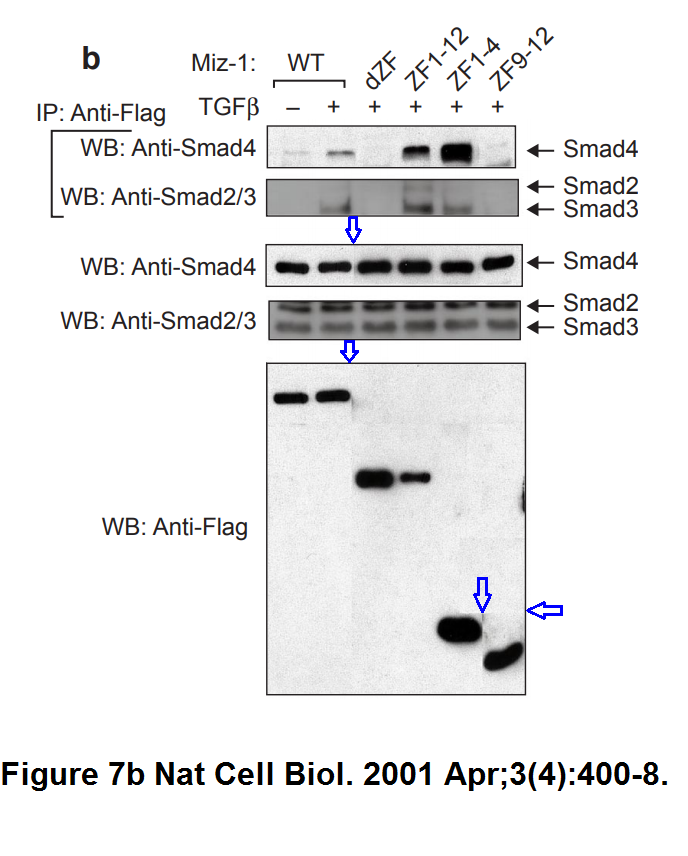
Joan Seoane , Celio Pouponnot , Peter Staller , Manuela Schader , Martin Eilers , Joan Massagué TGFbeta influences Myc, Miz-1 and Smad to control the CDK inhibitor p15INK4b Nature Cell Biology (2001) doi: 10.1038/35070086
What happened in the Anti-Flag image of the Figure 7b is a clear example of research misconduct. Look how bad the figure really is. I count at least 7 rectangles, a person who made this should be drummed out of science in shame. Or given a multimillion research grant and a huge lab with dozens of PhD students to train, I don’t know. Fact is that Massague made it to Sloan Kettering boss, and the first author Joan Seoane is now Director of the Translational Research Program at the Vall d’Hebron Institute of Oncology (VHIO) in Massague’s native Barcelona.
The penultimate author Martin Eilers, professor at the University of Würzburg, Germany, informed me:
“The figure is from the Massague lab.”
A paper with such an outrageously fake figure should be retracted, but this is for Massague to decide. And this almighty god of US and Spanish cancer research decided to do exactly nothing at all.
Can we trust these two papers? It’s “just” irregular gel splicing, sure, but why was it necessary for a four- or five-lane gel? Was it because the results were not that impactful otherwise?
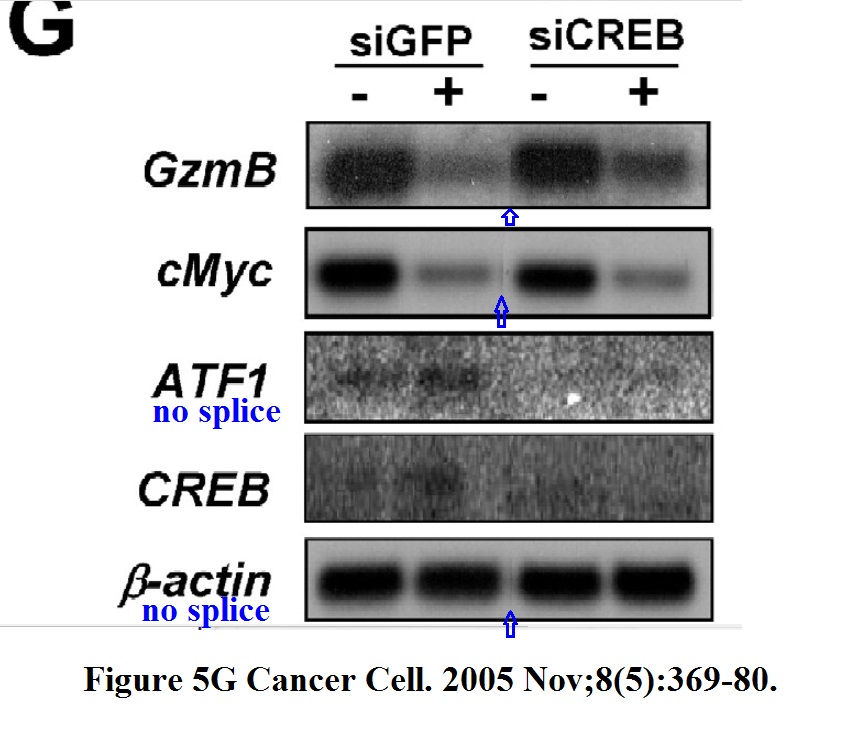

Irregular splicing renders the entire figure pointless. Because the readers and reviewers were mislead to believe they look at a properly controlled experiment, which it never was.
Here another paper by Massague, with another German collaborator, Christoph Niehrs, institute director at University of Mainz and German Cancer Research Centre (DKFZ).
Darya Onichtchouk , Ye-Guang Chen , Roland Dosch , Volker Gawantka , Hajo Delius , Joan Massagué, Christof Niehrs Silencing of TGF-beta signalling by the pseudoreceptor BAMBI Nature (1999) doi: 10.1038/46794
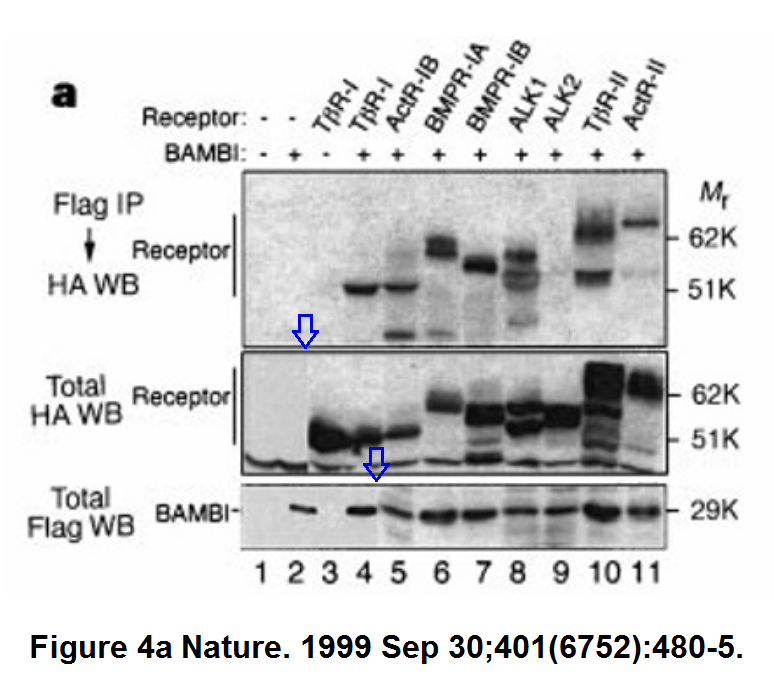
Niehrs wrote back to me:
“thank you for the valuable hint. I contacted the co-author responsible for the data from the then collaborating laboratory of Joan Massagué and we will place an erratum.“
Niehrs and his co-author Ye Guang Chen then commented on PubPeer:
“We note that the shown lanes with the arrows were indeed from separate gels and immunoblots that were spliced together later. The reason was that there were too many samples in that experiment to be loaded on one single gel, so they had to be split. Importantly though, all samples were from the very same experiment and are comparable. Nevertheless, we should have indicated this merging clearly and apologize for this omission. The omission does not affect the conclusion nor any statement of the publication.“
I am not sure if this makes sense. The first two lanes from the Total HA blot and the first 4 lanes of the Total Flag blot clearly have a different background from the rest. They can never be from the same gel, i.e. experimental analysis. Most obviously these spliced-on lanes stem from some other gels, which renders the entire figure and all of its conclusions void. At best.
Will there be at least a correction now? Presumably Massague said no. Let’s have a look at even older papers.
I Reynisdóttir , K Polyak , A Iavarone , J Massagué Kip/Cip and Ink4 Cdk inhibitors cooperate to induce cell cycle arrest in response to TGF-beta Genes & Development (1995) doi: 10.1101/gad.9.15.1831
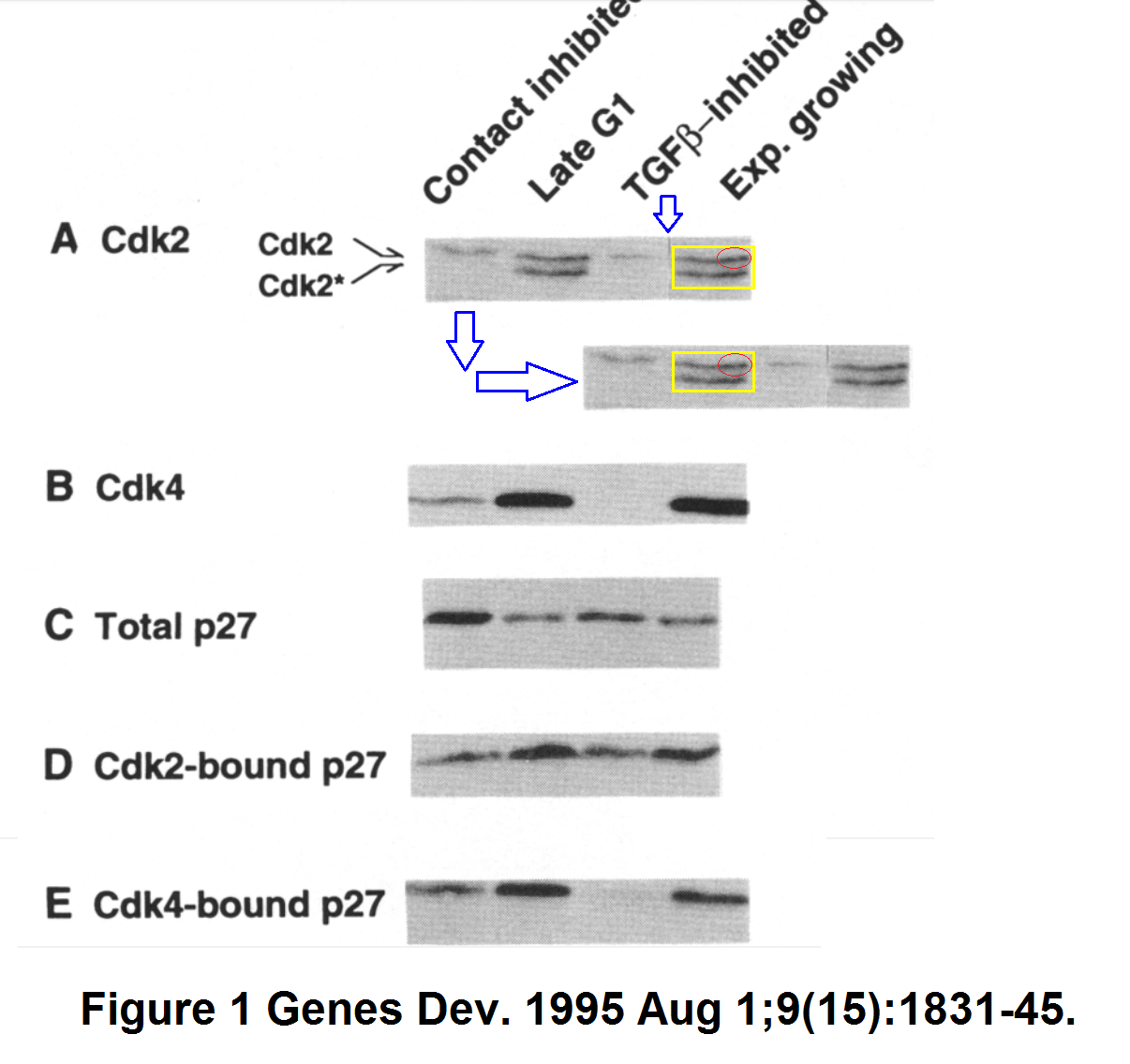
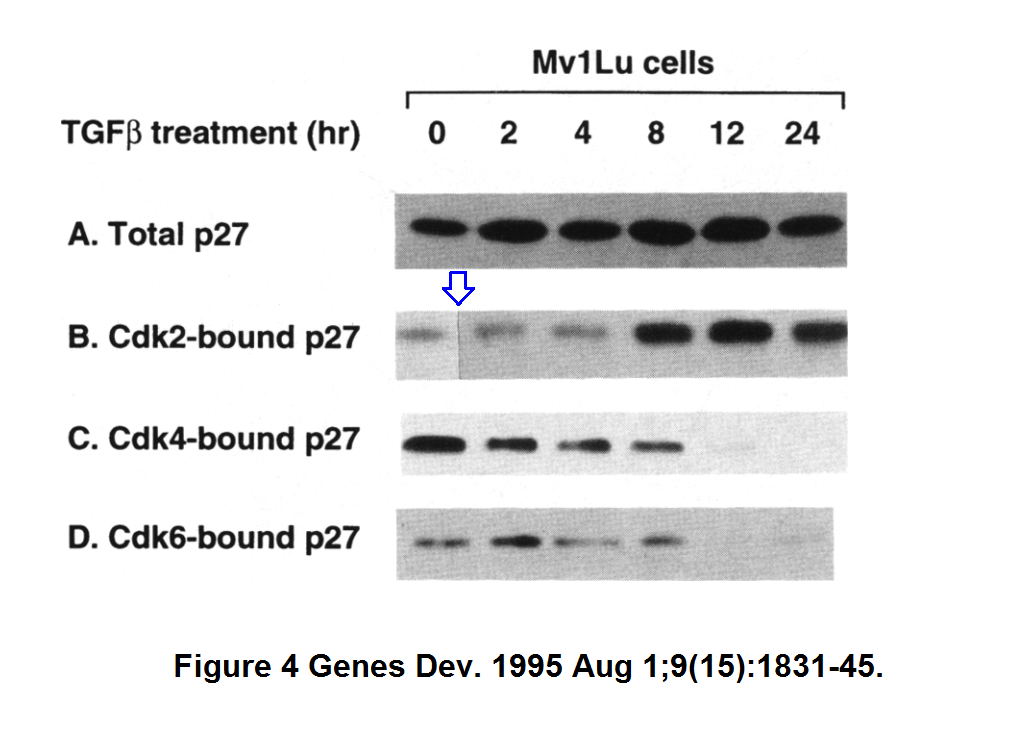
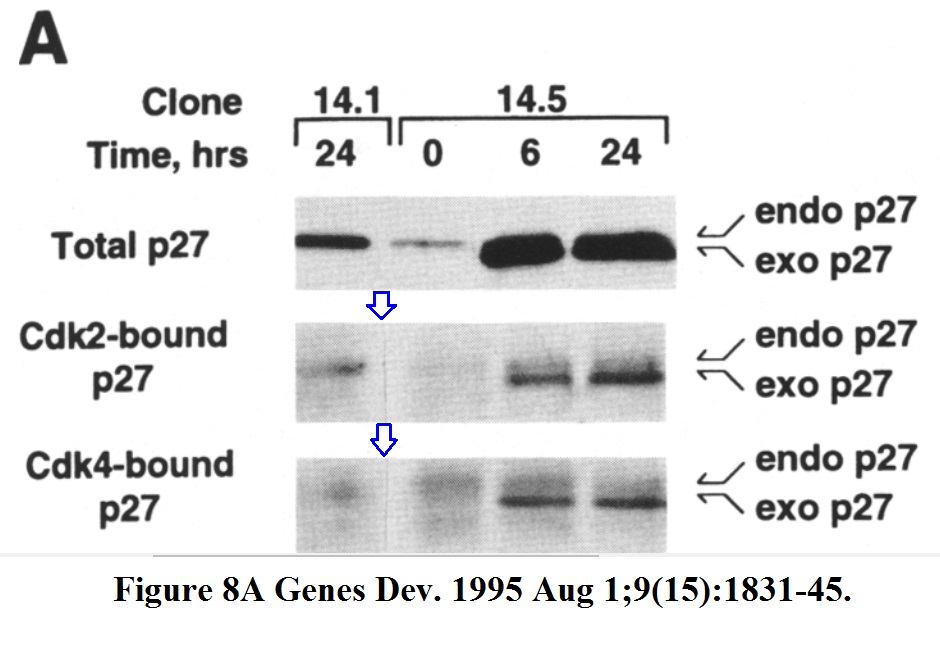
No Photoshop there, it’s the old artisan craft of paper-scissors-glue data fudgery which only the old generation of scientists learned to perform. The penultimate author Antonio Iavarone is professor at the Columbia University and has a PubPeer record of his own.
In another case of a very old Massague paper, the PubPeer criticism seemed not valid, like the alleged lane duplication, highlighted with blue boxes here:
Joaquı́n Arribas , Fernando López-Casillas , Joan Massagué Role of the juxtamembrane domains of the transforming growth factor-alpha precursor and the beta-amyloid precursor protein in regulated ectodomain shedding Journal of Biological Chemistry (1997) doi: 10.1074/jbc.272.27.17160

But a closer look revealed that the two “-PMA” “Media” blots completely lack the first lane, they are just cut-off there. The first author, Joaquin Arribas, now director of preclinical research at the aforementioned VHIO in Barcelona, did not reply when asked to explain.
Update 8.02.2022: Arribas now replied with an explanation:
“The lanes you refer to were not loaded. I did this experiment – 25 year ago! – as follows: cells were pulsed with radioactive amino acids for a short period of time. Then, labelling media was removed, cells were washed and fresh media was added. At the indicated times cells and conditioned media were harvested to analyse cell lysates and secreted material independently. Of course, there is no sample corresponding to media that has been conditioned 0 minutes by cells (as there is no samples corresponding to lysates or media of cells treated for 0 minutes with PMA). I did not add anything digitally, the blots just start there. Perhaps painting borders to openly show that there is no media conditioned for 0 minutes would have made clearer the presentation of the data.“
But all those were small potatoes of Massague’s legacy. The great oncologist was also mentor to Stacy Blain, now associate professor at SUNY Downstate and biomedical entrepreneur, who went on to have a PubPeer record of her own. Here some examples of Blain’s and Massague’s joint contribution to cancer research:
Beverley J. Warner , Stacy W. Blain, Joan Seoane , Joan Massagué Myc Downregulation by Transforming Growth Factor β Required for Activation of the p15 Ink4b G 1 Arrest Pathway Molecular and Cellular Biology (1999) doi: 10.1128/mcb.19.9.5913
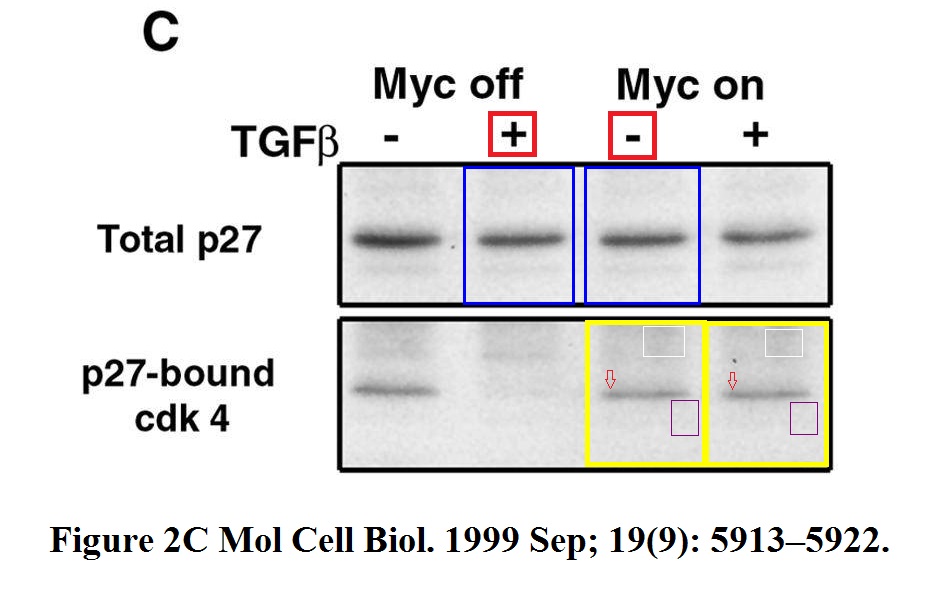
These papers are ancient, no journal will want to bother about those. But science like this formed the cancer research of today.
Stacy W. Blain, Ermelinda Montalvo , Joan Massagué Differential interaction of the cyclin-dependent kinase (Cdk) inhibitor p27Kip1 with cyclin A-Cdk2 and cyclin D2-Cdk4 Journal of Biological Chemistry (1997) doi: 10.1074/jbc.272.41.25863

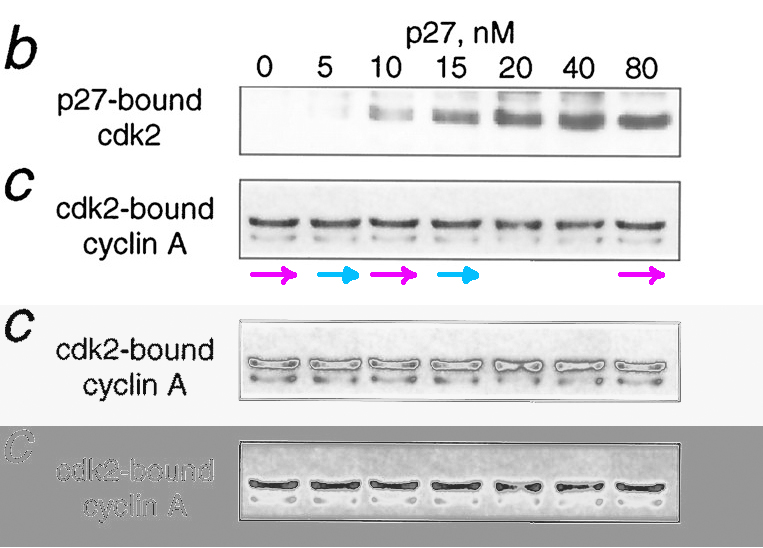
For a paper with just two authors, it’s not difficult to find the culprits.
Stacy W. Blain, Joan Massagué Different sensitivity of the transforming growth factor-beta cell cycle arrest pathway to c-Myc and MDM-2 Journal of Biological Chemistry (2000) doi: 10.1074/jbc.m006496200
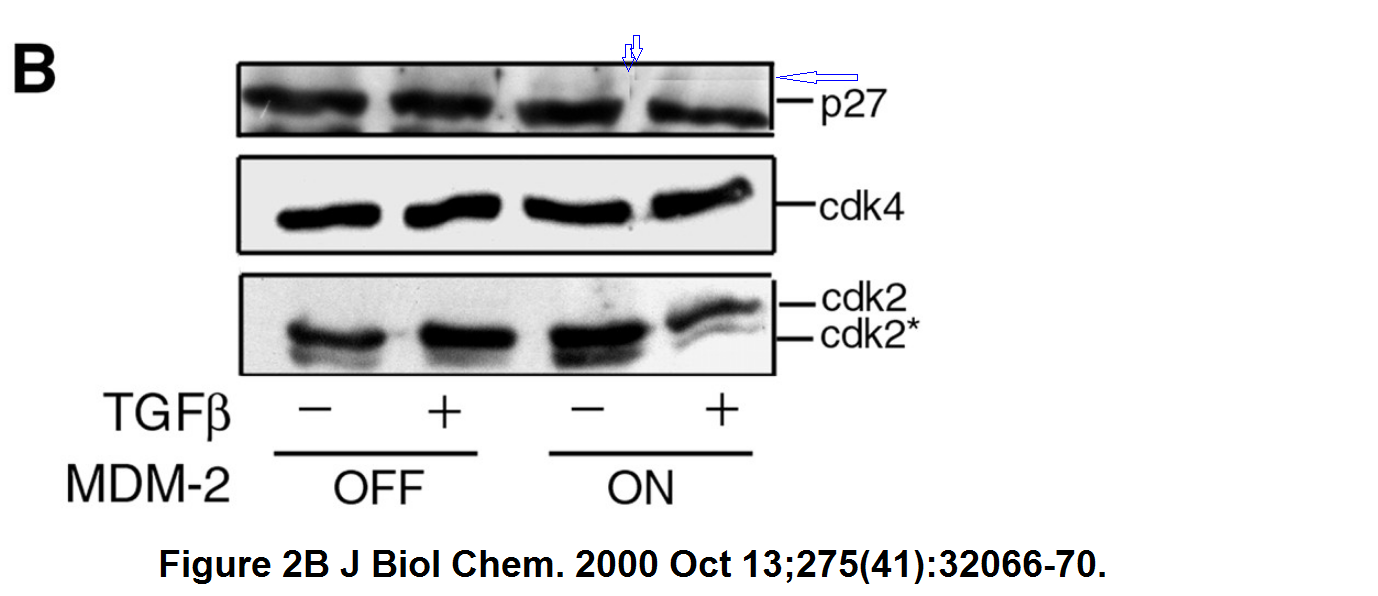
You have to look closer, the last p27 band was digitally inserted to cover up the result Drs Blain and Massague must have disapproved of.
Those were historical records, such easy to spot forgeries rarely happen in elite US labs nowadays. Not because they became honest, but because the methods have changed. The technology of the western blot, where every manipulation is evident if you bother to look, is becoming outdated or even embarrassing. But still, when western blot is used in newer papers, things like these happen:
Qing Chen , Adrienne Boire , Xin Jin , Manuel Valiente , Ekrem Emrah Er , Alejandro Lopez-Soto , Leni S. Jacob , Ruzeen Patwa , Hardik Shah , Ke Xu , Justin R. Cross , Joan Massagué Carcinoma–astrocyte gap junctions promote brain metastasis by cGAMP transfer Nature (2016) doi: 10.1038/nature18268

The TBK panel is same in both figures, just at different brightness. Massague replied on PubPeer right away in October 2016 and announced a correction:
“You are right that the TBK1 strip is the same in both figures, 4a and Ex9a. These are repeats of the same experiment done in two different cell lines. The equal loading of all the tracks is still clear based on the IRF3 and Actin data. Therefore, the validity of the results fortunately is not compromised by the error.”
The Nature correction from 2017 declared that there was even more:
“In this Article, Extended Data Figs 7d and 9a, presenting results obtained with the H2030-BrM3 cell line, contain errors that were introduced during the assembly of these figures in parallel with the corresponding panels in Figs 3b and 4a, which show the results of the same experiment but using a different cell line (MDA231-BrM2). The p65 loading control from Fig. 3b and the TBK1 loading control from Fig. 4a were duplicated in Extended Data Figs 7d and 9a, respectively. The STAT1 strip in Extended Data Fig. 7d was horizontally reversed. T[…] These errors do not alter the results or conclusions of the Article.”
Of course none of this can ever alter the results or conclusions of the Article, because articles like this are just conveyor-belt bullshit without any meaning for actual cancer therapies. Sure, the study claimed to have discovered a cure for brain cancer:
“The orally bioavailable modulators of gap junctions meclofenamate and tonabersat break this paracrine loop, and we provide proof-of-principle that these drugs could be used to treat established brain metastasis.“
A clinical trial with these drugs with brain tumour patients was registered by MSKCC in 2015 and never started. Probably because the results and conclusions of Massague’s Nature paper are that reliable.

If these preclinical discoveries do reach the clinical phase, they reliably fail in trials, but not without first having earned their professorial inventors hundreds of thousands or even millions of dollars. In this regard, Massague and his colleagues declared in that Nature paper “no competing financial interests“. In reality he holds several patents for treatment of brain tumours with meclofenamate and tonabersat. A bit reminiscent of how MSKCC president and another Spaniard, Jose Baselga, was dismissed in 2019 for hidden multi-million dollar-heavy conflicts of interests (actually, hiding financial COIs is standard practice in biomedical research). Money can’t buy everything though: Baselga died in 2021 from a neurodegenerative disease aged just 61, and then it became impolite to even mention his earlier sacking.
Here an even newer paper from the Massague lab, it’s all diagrams now, no more treacherous western blots.
Karuna Ganesh , Harihar Basnet , Yasemin Kaygusuz , Ashley M. Laughney , Lan He , Roshan Sharma , Kevin P. O’Rourke , Vincent P. Reuter , Yun-Han Huang , Mesruh Turkekul , Ekrem Emrah Er , Ignas Masilionis , Katia Manova-Todorova , Martin R. Weiser , Leonard B. Saltz , Julio Garcia-Aguilar , Richard Koche , Scott W. Lowe , Dana Pe’er , Jinru Shia , Joan Massagué L1CAM defines the regenerative origin of metastasis-initiating cells in colorectal cancer Nature Cancer (2020) doi: 10.1038/s43018-019-0006-x

Massague replied on PubPeer right away:
“We regret to have missed this accidental duplication in the course of putting together the figure. Remarkably, our error was there from the outset, yet the authors, the referees, and the editors all missed it through two rounds of review! We are thankful that the reader caught this error at last.“
The reviewers and editors missed it because papers by someone like Massague are peer-reviewed differently than papers from pedestrian scientists. A correction was issued a few months later:

There may be more in Massague’s papers if one bothers to search. But what’s the point? None of that affects his conclusions.
PS: because a fish always rots from its head, at MSKCC even plagiarism is acceptable.
Contact form
I thank all my donors for supporting my journalism. You can be one of them!
Make a one-time donation:
I thank all my donors for supporting my journalism. You can be one of them!
Make a monthly donation:
Choose an amount
Or enter a custom amount
Your contribution is appreciated.
Your contribution is appreciated.
DonateDonate monthly



Like many others, I would say 80%+, of the scientists in renowned institutions across the world they not only not have time to correct old and new papers but also actively engage in relationships with governments and high impact journals. And therefore are unable to answer to very simply questions like if HIV-1 or Sars-Cov-2 were isolated for example.
LikeLike
” A bit reminiscent of how MSKCC president and another Spaniard, Jose Baselga, was dismissed in 2019 for hidden multi-million dollar-heavy conflicts of interests (actually, hiding financial COIs is standard practice in biomedical research).”
Problematic data to boot:-
https://pubpeer.com/publications/9F1D4185DE5A78677859CE5C2B3ECF
https://pubpeer.com/publications/19E83ADDD5A0D4565CDE1110FAC98C
https://pubpeer.com/publications/3AD7FAA60B3CFCAD086EF25544B65C#5
https://pubpeer.com/publications/2A4525E83961E4BB164193088DCEE7#1
https://pubpeer.com/publications/3B0E4832BAFF372C36C82BE7C7D4D7
LikeLike
” A bit reminiscent of how MSKCC president and another Spaniard, Jose Baselga, was dismissed in 2019 for hidden multi-million dollar-heavy conflicts of interests (actually, hiding financial COIs is standard practice in biomedical research).”
https://pubpeer.com/publications/7781EDA8A5E44E398A71394ADED46D
Not good at arithmetic.
LikeLike
“For example, surely we can trust Joan Massagué, Spanish-born director of the Sloan Kettering Institute, part of Memorial Sloan Kettering Cancer Center (MSKCC) in New York?”
Cancer Res. 2005 Mar 15;65(6):2186-92.
p73β-Mediated Apoptosis Requires p57kip2 Induction and IEX-1 Inhibition
Susana Gonzalez, Manuel M. Perez-Perez, Eva Hernando, Manuel Serrano and Carlos Cordon-Cardo
DOI: 10.1158/0008-5472.CAN-04-3047 Published March 2005
https://cancerres.aacrjournals.org/content/65/6/2186.article-info
AUTHOR INFORMATION
Susana Gonzalez1,2, Manuel M. Perez-Perez1, Eva Hernando1, Manuel Serrano2, and Carlos Cordon-Cardo1
1Department of Pathology, Memorial Sloan-Kettering Cancer Center, New York, New York and
2Molecular Oncology Program, Spanish National Cancer Centre, Madrid, Spain
Requests for reprints:
Carlos Cordon-Cardo, Department of Pathology, Memorial Sloan-Kettering Cancer Center, New York, NY. Phone: 212-639-7746; Fax: 212-794-3186; E-mail: sgonzalez@cnio.es
What a coincidence!
Pubpeer: https://pubpeer.com/publications/ABB7746FD5493450293B8B1F2BBA61
When all the elm trees in the elm grove have Dutch elm disease, yet this one doesn’t?
https://forbetterscience.com/2017/09/21/carol-prives-innocent-victim-of-susana-gonzalez-data-manipulations/
Carlos Cordon-Cardo has notched up more than a few:
https://pubpeer.com/search?q=carlos+cordon-cardo
LikeLike
Joan Massage/David M Sabatini
TGF-β/mTor
Untouchable/Untouchable
Nobel Price candidate/Nobel Price candidate
Are there more parallelisms related to female scientists?
LikeLike
One of my all time favorite fake cancer research paper:
https://pubpeer.com/publications/866C1718DA48F671DB1AB8F114E186
LikeLike
Never retracted, corrected or expression concerned.
218 citations.
https://clincancerres.aacrjournals.org/content/17/12/3993.article-info
Saad almost became rector of his university last year.
https://forbetterscience.com/2021/03/19/criaremos-na-unicamp-um-escritorio-permanente-de-integridade-em-pesquisa-para-proteger-a-sociedade-e-o-pesquisador-afirma-mario-saad/
LikeLike
Regarding the final paper mentioned, Ganesh et al. (2020), doi: 10.1038/s43018-019-0006-x: such mistakes when putting figures together do in fact happen, and I can belief this to be an accident. I’ve made similar mistakes myself. Fortunately, so far, I always caught them before the final publication of a paper. But it has happened that I found mistakes like this during proof correction, after more than one round of reviews.
I think such mistakes are easier to make when creating diagrams like this compared to something like western blots or photographs. In the creation of a diagram figure, there is always some assembly to be done. You’re selecting which columns in your file have the labels, which ones have the values, which ones the error values, etc. Occasionally you might select column 237 again instead of 239…
Photographic figures, including western blots, should normally be presented close to how they were created, with next to no work done to the figure. So, in theory, there should be less chances of errors there.
LikeLike
Surely we can also trust big scientist Eric Lander.
According to Science, White House science adviser Eric Lander resigns after bullying investigation.
Another staffer not quoted by name told Politico that Lander has a “Jekyll and Hyde personality,” pleasant in public meetings but harsh behind closed doors.
Is this bullying investigation limited to White House? Eric Lander is the president and founder director of the Broad Institute (MIT, Harvard).
Broad Institute, Whitehead Institute (Sabatini), … what’s happening at MIT?
https://www.science.org/content/article/white-house-science-adviser-eric-lander-under-fire-bullying
LikeLike
Oh thanks, I missed this news.
Lander founded a biotech company Codyak Bio with Raghu Kalluri, marketing the fraudulent exosome research from Kalluri and Sonia Melo.
https://forbetterscience.com/2016/02/10/sonia-melo-case-phd-advisor-esteller-investigated-postdoc-pi-kalluri-with-80mio-coi/
Bullying strangely goes hand in hand with bad science.
LikeLike
I cannot believe Eric Lander was bullying women in White House, Office of Science and Technology Policy (OSTP), but he was an angel to his staff at Broad Institute. That’s not possible.
So, I guess MIT is planning to review Lander’s behavior for the last 30 years.
LikeLike
All they need is another lawsuit. The $45 million heavy Lander is not to be trifled with.
LikeLike
It was a culture clash! OSTP people are snowflakes, in academia bullies like Lander are seen as mild to moderate. Just right in fact.
LikeLiked by 1 person
According to The Wall Street Journal, science adviser Eric Lander was among Biden’s Wealthiest Cabinet Officials, $45 million
LikeLike
Exactly right about the culture clash. Few people in academia, especially low paid research staff on visa, would dare complaining about the boss being demeaning (or worst). Business as usual, even if things are starting to change, very slowly.
LikeLike
“The great oncologist was also mentor to Stacy Blain, now associate professor at SUNY Downstate and biomedical entrepreneur, who went on to have a PubPeer record of her own. ”
https://www.pacermonitor.com/public/case/44636794/Blain_v_State_University_of_New_York_Downstate_Medical_Center_et_al
Thursday, August 25, 2022
37 motion Temporary Restraining Order Thu 08/25 3:34 PM
Letter MOTION for Temporary Restraining Order concerning Expressions of Concern by Stacy Blain. (Gay, Faith)
LikeLike
22 Aug 2022 Expression of Concern. https://journals.asm.org/doi/10.1128/mcb.00324-22
The American Society for Microbiology (ASM) and Molecular and Cellular Biology (MCB) are issuing this Expression of Concern regarding the following publication:
Ray A, James MK, Larochelle S, Fisher RP, Blain SW. 2009. p27Kip1 inhibits cyclin D–cyclin-dependent kinase 4 by two independent modes. Mol Cell Biol 29(4):986–999. https://doi.org/10.1128/MCB.00898-08.
Molecular and Cellular Biology was notified that the above-mentioned paper was investigated by the SUNY Downstate Health Sciences University and that potential image duplications were found in Fig. 3A. This Expression of Concern is issued pending the outcome of ongoing litigation between SUNY Downstate Health Sciences University and the corresponding author of the paper, Stacy Blain, in the U.S. District Court of the Eastern District of New York.
LikeLike
22 Aug 2022 Expression of Concern. https://journals.asm.org/doi/10.1128/mcb.00322-22
The American Society for Microbiology (ASM) and Molecular and Cellular Biology (MCB) are issuing this Expression of Concern regarding the following publication:
Patel P, Asbach B, Shteyn E, Gomez C, Coltoff A, Bhuyan S, Tyner AL, Wagner R, Blain SW. 2015. Brk/protein tyrosine kinase 6 phosphorylates p27KIP1, regulating the activity of cyclin D–cyclin-dependent kinase 4. Mol Cell Biol 35(9):1506–1522. https://doi.org/10.1128/MCB.01206-14.
Molecular and Cellular Biology was notified that the above-mentioned paper was investigated by the SUNY Downstate Health Sciences University and that potential image duplications were found in Fig. 2C, H, and I. This Expression of Concern is issued pending the outcome of ongoing litigation between SUNY Downstate Health Sciences University and the corresponding author of the paper, Stacy Blain, in the United States District Court of the Eastern District of New York.
LikeLike
22 Aug 2022 Expression of Concern. https://journals.asm.org/doi/10.1128/mcb.00323-22
The American Society for Microbiology (ASM) and Molecular and Cellular Biology (MCB) are issuing this Expression of Concern regarding the following publication:
James MK, Ray A, Leznova D, Blain SW. 2008. Differential modification of p27Kip1 controls its cyclin D-cdk4 inhibitory activity. Mol Cell Biol 28:498–510. https://doi.org/10.1128/MCB.02171-06.
Molecular and Cellular Biology was notified that the above-mentioned paper was investigated by the SUNY Downstate Health Sciences University and that potential image duplications were found in Fig. 3A and 6B. This Expression of Concern is issued pending the outcome of ongoing litigation between SUNY Downstate Health Sciences University and the corresponding author of the paper, Stacy Blain, in the United States. District Court of the Eastern District of New York.
LikeLike
Click to access gov.uscourts.nyed.480260.1.0.pdf
LikeLike
Good luck Stacy. Very clever to sue your employer over expressions of concern.
LikeLike
“As detailed in the pages that follow, Defendant SUNY Downstate’s discrimination against Dr. Blain includes chronically underpaying her (as compared to her male colleagues), refusing to promote her, depriving her of pecuniary and non-pecuniary resources that are available to her male colleagues, and creating a hostile work environment.
After Dr. Blain complained about these problems, the Defendants began a brutal campaign of retaliation against her. As the main tool in this war, Defendant SUNY Downstate weaponized a three-year-old claim of “research misconduct” — which had been investigated three times and, in each instance, Defendant SUNY Downstate cleared her of any wrongdoing1 — and
convened a panel of three men, who proceeded to conduct a biased and predetermined investigation, with no new evidence, to come to the opposite finding of “negligently” failing to supervise a student, which they claim supports their finding of research misconduct.”
WHERE IS MCLNEURO WHEN YOU NEED HER???!!!
LikeLike
“In or about 2016, Jane Doe 1 — the student whom Dr. Stewart allowed to take long unexplained leaves of absences that caused serious disruptions to the work in Dr. Blain’s laboratory — accused John Doe 1, another graduate student at the time, of committing research misconduct. Her accusations included mishandling and mislabeling figures in a not-yet-published
paper. The accusations also related to figures in a 2015 paper that Jane Doe 1, John Doe 1, Dr.
Blain, and others published in Molecular and Cellular Biology (the “2015 MCB Paper”) Dr. Blain took Jane Doe 1’s allegations of research misconduct seriously, and asked a colleague, Dr. Miriam Feuerman (“Dr. Feuerman”), to review John Doe 1’s figures in the not-yet-published paper and the 2015 MCB Paper. Dr. Feuerman is an Associate Professor of Cell
Biology at SUNY Downstate. She is an expert in, and has broad experience with, the type of
research John Doe 1 was conducting.
38. After an extensive investigation (the “Feuerman Investigation”), which included reviewing the primary data supporting John Doe 1’s figures, Dr. Feuerman concluded that the allegations were unsubstantiated, and that John Doe 1 had not engaged in research misconduct.
39. Following the Feuerman Investigation, in or about 2016, Dr. Stewart, as dean of Defendant SUNY Downstate’s School of Graduate Studies, initiated another investigation into the allegations. This second investigation was conducted by Dr. William Chirico (“Dr. Chirico”) and Dr. Lorin Weiner (“Dr. Weiner”) (the “Chirico and Weiner Investigation,” and together with the Feuerman Investigation, the “2016 Investigations”). The Chirico and Weiner Investigation was thorough and lasted several months. It thoroughly examined John Doe 1’s figures. Dr. Blain cooperated fully with the Chirico and Weiner Investigation.
40. The Chirico and Weiner Investigation ultimately reached the same result as the Feuerman Investigation: it did not find any evidence of research misconduct by John Doe 1, Dr. Blain, or anyone else.”
Probably this one?
https://pubpeer.com/publications/A66D142101CB042AFA896E4FA36E71
LikeLike
“Given that there was no finding that John Doe 1 had conducted research misconduct, he was allowed to graduate in 2017. Shortly after his graduation, he joined Concarlo and worked there until about October 2019”
John Doe 1 is Priyank Patel.
https://www.linkedin.com/in/priyank-patel-8a235a107/
LikeLike
22 Aug 2022 Expression of Concern. https://journals.asm.org/doi/10.1128/mcb.00322-22
The American Society for Microbiology (ASM) and Molecular and Cellular Biology (MCB) are issuing this Expression of Concern regarding the following publication:
Patel P, Asbach B, Shteyn E, Gomez C, Coltoff A, Bhuyan S, Tyner AL, Wagner R, Blain SW. 2015. Brk/protein tyrosine kinase 6 phosphorylates p27KIP1, regulating the activity of cyclin D–cyclin-dependent kinase 4. Mol Cell Biol 35(9):1506–1522. https://doi.org/10.1128/MCB.01206-14.
Molecular and Cellular Biology was notified that the above-mentioned paper was investigated by the SUNY Downstate Health Sciences University and that potential image duplications were found in Fig. 2C, H, and I. This Expression of Concern is issued pending the outcome of ongoing litigation between SUNY Downstate Health Sciences University and the corresponding author of the paper, Stacy Blain, in the United States District Court of the Eastern District of New York.
LikeLike
Why doesn’t Memorial Sloan-Kettering Cancer Center follow SUNY Downstate’s lead and request retraction?
https://pubpeer.com/publications/8507E12CC66CA1F853B1F05F139BFB
https://pubpeer.com/publications/BFF9F09E15DDB01ECE4BE1BE29EBCC
LikeLike
Is that because the Memorial Sloan-Kettering Cancer Center is less interested in scientific integrity and the patients’ best interests , but more interested in money-making, and lining its own pockets?
New York Times fails to mention Jose Baselga’s problematic data.
https://pubpeer.com/search?q=jose+baselga
LikeLike
“The Chirico and Weiner Investigation ultimately reached the same result as the Feuerman Investigation: it did not find any evidence of research misconduct by John Doe 1, Dr. Blain, or anyone else.” Also referred to as “2016 Investigations”
Probably this one?
https://pubpeer.com/publications/A66D142101CB042AFA896E4FA36E71
That is most likely.
That paper has quite a lot of problematic data.
The 2016 investigations seem to be about one published paper.
The 2019 investigations were wider in that 4 papers were requested to be retracted. The 4 include the paper investigated in 2016, but it is not the same investigation.
Somebody from outside SUNY can see the problematic data in the paper investigated in 2016 and come to very similar conclusions (seeing the same problematic data). That is not surprising. That same person altered SUNY to the problematic data. SUNY had a duty to investigate.
When there is just one problematic paper it is more likely that the authors will be given the benefit of the doubt, but when there are 4 problematic papers that is less likely.
The premise by Stacy Blain’s lawyers that the same investigation was used out of spite against Stacy Blain is false. Are they not aware of Pubpeer and other public websites where people can post their concerns. Are they not aware that the authorities can be alerted by people across the world, not just along the same corridor as them?
Rushing to court carries the danger that the judge may find criminal activity.
LikeLike
“Somebody from outside SUNY can see the problematic data in the paper investigated in 2016 and come to very similar conclusions (seeing the same problematic data). That is not surprising. That same person [alerted] SUNY to the problematic data. SUNY had a duty to investigate.
https://retractionwatch.com/2022/08/25/exclusive-cancer-researcher-sues-med-school-for-retaliation-after-research-misconduct-finding/
It was Claire Francis.
SUNY did react. Claire Francis also alerted the NIH.
Perhaps the NIH has made a finding of scientific misconduct.
Public exposure of problematic data does not hinder investigations it is the reason they happen.
Public exposure does not alter the data.
LikeLike
It was a screen of Joan Massague’s (big fish) papers that brought Stacy Blain (small fish) to light, not the other way around. Why would somebody start a screen of a small fishes papers?
LikeLike
So what spelling shall I use? Clare Francis or Claire Francis?
LikeLike
Either. Real name Clare, the “i” is a later affectation, and to make it mean something in French.
LikeLiked by 1 person
” The great oncologist was also mentor to Stacy Blain, now associate professor at SUNY Downstate and biomedical entrepreneur, who went on to have a PubPeer record of her own.”
And doing very well according to Princeton! Princeton produces propaganda (sorry, supports) for its financially successful alumni. Princeton certainly knows how much Stacy Blain’s company is worth with an eye to getting some of that sum.
https://entrepreneurs.princeton.edu/news/2022/catching-stacy-blain-89
“Claire Shin ’25
June 27, 2022
Blain and her biotech startup Concarlo Therapeutics have made a great deal of progress over the past year and a half.
The company closed a seed round of $6.6 million in funding and is doing a $4 million Series AA (or pre-A) round with plans to start a Series A round this summer.”
Stacy Blain didn’t disclose the 2019 investigation to Princeton, or perhaps it didn’t ask.
More shocking.
“Concarlo has also renewed a contract with the NIH nanoparticle characterization laboratory, which Blain describes as a grant but even better – not only will Concarlo receive funding, but the NIH’s scientists would also help perform important research on the physio-chemical properties of the nanoparticle-based drug Concarlo is producing. ”
Make no mistake, Princeton will be thinking of Princeton’s best interest. It’s not a university for nothing.
Expect to hear more propaganda for Stacy Blain from Princeton soon. One good turn deserves another as they say!
LikeLike
I was always convinced that cancer can only be cured with nanoparticles. Dr Blain is certainly the right kind of scientist to make it happen.
LikeLike
Pingback: Prof Elizalde’s Magic Cancer Research at CONICET – For Better Science
Proc Natl Acad Sci U S A . 2006 Aug 22;103(34):12747-52. doi: 10.1073/pnas.0605333103. Epub 2006 Aug 14.
A FoxO-Smad synexpression group in human keratinocytes
Roger R Gomis 1, Claudio Alarcón, Wei He, Qiongqing Wang, Joan Seoane, Alex Lash, Joan Massagué
Affiliation
1
Cancer Biology and Genetics Program, Howard Hughes Medical Institute, and Bioinformatics Core Facility, Memorial Sloan-Kettering Cancer Center, New York, NY 10021, USA.
PMID: 16908841 PMCID: PMC1568919 DOI: 10.1073/pnas.0605333103
Problematic data figure 2D. Much more similar than expected.
LikeLike
J Biol Chem . 2000 Oct 13;275(41):32066-70. doi: 10.1074/jbc.M006496200.
Different sensitivity of the transforming growth factor-beta cell cycle arrest pathway to c-Myc and MDM-2
S W Blain 1 , J Massagué
Affiliations
Affiliation
Problematic data figure 1A. Much more similar than expected. Constellation of dark spots inside the 2 blue rectangles is very similar.
It helps to look at the screen in a dark room.
LikeLike